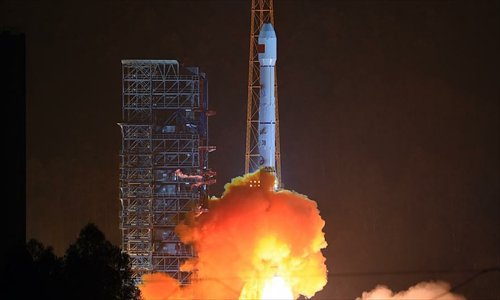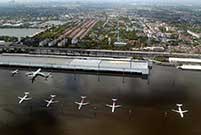

 |
| Photo taken on Dec. 29, 2015 shows the Long March-3B carrier rocket is launched with the Gaofen-4 Satellite in Xichang of southwest China's Sichuan Province. China on Tuesday launched its most sophisticated observation satellite, Gaofen-4, as part of the country's high-definition (HD) earth observation project. Photo: Xinhua |
China closed 2015 with the launch of its most sophisticated observation satellite on Tuesday, and a record number of rockets are expected to blast off as part of its ambitious space program in the coming year.
The satellite, Gaofen 4, was launched from the Xichang Satellite Launch Center in Southwest China's Sichuan Province at 00:04 am aboard a Long March 3B carrier rocket. It was the 222nd flight of the Long March rocket series, according to the State Administration of Science, Technology and Industry for National Defense (SASTIND).
Gaofen 4 is China's first geosynchronous orbit high-definition (HD) optical imaging satellite and the world's most sophisticated HD geosynchronous orbit remote sensing satellite, which will be used for disaster prevention and relief, surveillance of geological disasters and forest disasters, as well as weather forecasting, the China National Space Administration reported on Tuesday.
The successful launch of Gaofen 4 was China's 19th space mission this year.
"Gaofen 4 represents China's crowning achievement in development of remote sensing satellites. There is no similar satellite that can be on par with it globally," Tong Xudong, the chief designer of the Gaofen project at SASTIND, told the Global Times.
Gaofen 4 is located at the orbit 36,000 kilometers above the earth, with a designed lifespan of eight years, which is a new record for China's satellites, Tong added.
"The successful launch of Gaofen 4 is a milestone in the development of geosynchronous orbit remote sensing satellites in China, since the technology is quite sophisticated and advanced," Jiao Weixin, a space science professor at Peking University, told the Global Times on Tuesday.
According to Jiao, low orbit satellites cannot always follow dynamic natural disasters, but Gaofen 4 can continuously observe them because it moves synchronously with the earth. It also improves the response to disasters like earthquakes, landslides and typhoons with its high-precision sensors.
The satellite can see the entire area of Beijing and Tianjin at one glance. It will benefit countries and regions covered by the "Belt and Road" Initiative as well as provide services for various domestic industries, Li told Xinhua.
Booming industry
China's space program has made great improvements in the past five years and laid a solid foundation for the future development of the country's space industry, Jiao said.
China Aerospace Science and Technology Corporation has launched 86 rockets and 138 satellites during the 12th Five-Year-Plan period (2011-15) with a launch success rate of 97.7 percent, while the number of launched spacecraft has doubled compared to that during the 11th Five-Year-Plan period, the China News Service reported Tuesday.
Meanwhile, the China Academy of Launch Vehicle Technology (CALT) under the China Aerospace Science and Technology Corporation has carried out 10 international commercial launches in the past five years. A total of 31 spaceflight cooperation agreements were signed during the 12th Five-Year-Plan period.
CALT alone will design and produce 15 carrier rockets in 2016, an unprecedented number in the company's history, and launch its new models of carrier rockets including the Long March 5 and the Long March 7. The total number of rockets to be launched in 2016 is expected to hit a new high.
Meanwhile, the company is planning to initiate the largest carrier rocket production project in China's aerospace history and reduce the production cycle from 5-6 years to 2-3 years.
China's aerospace industry is improving swiftly. With a relatively low launch cost and reliable technologies, more countries will cooperate with China in spaceflight and space launch in the future, Jiao said.
Despite the promising future, some experts pointed out that China's space industry still has a long way to go to catch up with its Western competitors such as the US.
"Currently China is a major aerospace country, not a strong power. Though the future is promising, the country still needs to make more efforts on the development of aerospace technologies," a Beijing-based expert on spaceflight, who asked to remain anonymous, told the Global Times Tuesday.
 Are these the world’s scariest landing strips?
Are these the world’s scariest landing strips? In pics: Left behind children in China
In pics: Left behind children in China Eight modern day engineering marvels of China
Eight modern day engineering marvels of China Chinese beauty with sexiest bottom
Chinese beauty with sexiest bottom Charming female bodybuilders of Chengdu University
Charming female bodybuilders of Chengdu University Polish sports stars strip off for risqué calendar
Polish sports stars strip off for risqué calendar Spectacular aerial photos of the Three Gorges
Spectacular aerial photos of the Three Gorges Contestants of Mrs. Globe pose for photo in Shenzhen
Contestants of Mrs. Globe pose for photo in Shenzhen
 Bikini models attend hot pot banquet in Hefei
Bikini models attend hot pot banquet in Hefei Top 20 hottest women in the world in 2014
Top 20 hottest women in the world in 2014 Top 10 hardest languages to learn
Top 10 hardest languages to learn 10 Chinese female stars with most beautiful faces
10 Chinese female stars with most beautiful faces China’s Top 10 Unique Bridges, Highways and Roads
China’s Top 10 Unique Bridges, Highways and Roads Laowai Internet sensations
Laowai Internet sensations Comfort women deal will not aid Tokyo
Comfort women deal will not aid Tokyo Parents demand air purifiers be installed in schools, not all successful
Parents demand air purifiers be installed in schools, not all successful A sign of disaffection, rural worship of Chairman Mao is treated with caution
A sign of disaffection, rural worship of Chairman Mao is treated with cautionDay|Week